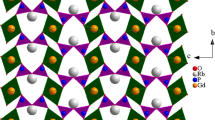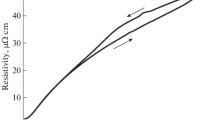Abstract
The electrical resistivity of protactinium metal has been measured between 0.90 and 300 K. The absolute value of the resistivity is between that of thorium and uranium, with ρ 298 =19.28 µ Ω-cm. A change in slope of the resistivity was observed at 103 K and remains unexplained. No superconductivity was observed down to 0.9 K. The resistivity ratio ρ 273 /ρ o was 9.27, showing the sample to be reasonably pure.
Similar content being viewed by others
References
A. Goble, J. Golden, A. G. Maddock, and D. T. Toms,Progress in Nuclear Energy, Series 3, F. B. Bruce, J. M. Fletcher, and H. H. Hyman, eds. (Pergamon Press, London, 1958), Vol. II, p. 86.
J. S. Nairn, D. A. Collins, H. A. C. McKay, and A. G. Maddock, inProc. 2nd U.N. International Conference on the Peaceful Uses of Atomic Energy, Geneva (1958), Vol. XVIII, p. 216.
W. H. Zachariasen,Acta Cryst. 5, 19 (1952).
J. A. C. Marples,Acta Cryst. 18, 815 (1965).
B. B. Cunninghan, inPhysico-Chemie du Protactinium (CNRS, Paris, 1966), p. 45.
L. B. Asprey, R. D. Fowler, J. D. G. Lindsay, R. W. White, and B. B. Cunningham,Inorg. Nucl. Chem. Lett. 7, 977 (1971).
R. D. Fowler, B. T. Matthias, L. B. Asprey, H. H. Hill, J. D. G. Lindsay, C. E. Olsen, and R. W. White,Phys. Rev. Lett. 15, 860 (1965).
R. D. Fowler, L. B. Asprey, J. D. G. Lindsay, and R. W. White, Los Alamos Report 72/919; also inProc. 13th Int. Conf. Low Temp. Phys. (Plenum, New York, 1974).
B. M. Bansal, Thesis, University of California—Berkeley, UCRL No. 16782 (1966).
R. H. Dod, Thesis, University of California—Berkeley, LBL659 (1970).
C. S. Griffin, K. Mendelssohn, and M. J. Mortimer,Cryogenics 8, 110 (1968).
J. A. C. Marples, inPhysico-Chemie du Protactinium (CNRS, Paris, 1966), p. 39.
G. T. Meaden,Proc. R. Soc. (Lond.)276A, 553 (1963).
D. T. Peterson, D. F. Page, R. B. Rump, and D. K. Finnimore,Phys. Rev. 153, 701 (1967).
S. Arajs and R. V. Colvin,J. Less Common Metals 7, 54 (1964).
C. S. Griffin, D. Phil. Thesis, University of Oxford (1968).
C. S. Griffin, K. Mendelssohn, J. A. Lee, and M. J. Mortimer, in Proc. 4th Int. Conf. on Plutonium and Other Actinides, Santa Fe, New Mexico,Nuclear Metallurgy 17, 635 (1970).
R. Schenkel, H. E. Schmidt, and J. C. Spirlet, in4th Int. Transplutonium Symposium (North-Holland, Amsterdam, 1976), p. 149.
M. J. Mortimer, D. Phil. Thesis, University of Oxford (1972).
J. Fuger, private communication.
Author information
Authors and Affiliations
Rights and permissions
About this article
Cite this article
Hall, R.O.A., Lee, J.A. & Mortimer, M.J. The electrical resistivity of protactinium metal. J Low Temp Phys 27, 305–311 (1977). https://doi.org/10.1007/BF00654651
Received:
Issue Date:
DOI: https://doi.org/10.1007/BF00654651




